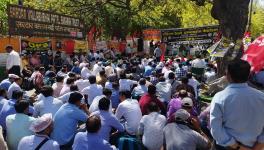Unified Pension Scheme is a Policy to Loot Employees’ Savings: AIPF

Retired transport employees in TN ( File photo)
New Delhi: Demanding restoration of the Old Pension Scheme (OPS), the All-India Peoples’ Front (AIPF), headed by social activist and former top cop, S R Darapuri, has said the new Unified Pension Scheme (UPS) is a “policy to loot” people’s retirement savings.
In a statement, AIPF said the by introducing UPS, the government was planning to “seize the entire amount contributed by employees.”
“The Unified Pension Scheme does not mention any provision for Dearness Allowance (DA) on the pension amount at the time of retirement. Inflation indexing or Dearness Relief will be provided after receiving the assured pension. The government has also stated that, in addition to gratuity, employees will receive a lump sum payment at the time of retirement. This lump sum will be calculated based on 10% of their final salary, including DA, multiplied by the number of half-year periods of their service. For example, if an employee’s service period is 25 years and their final salary is ₹1 lakh, they will receive a lump sum payment of ₹5 lakh (₹10,000 multiplied by 50 half-year periods). However, the scheme is silent on what will happen to the employees’ 10% contribution and the government’s 18.5% contribution made during their service. It is well known that there was no such contribution under the Old Pension Scheme. Even under the New Pension Scheme, 60% of the contribution was paid to employees at the time of retirement. But in this new scheme, there is no provision for receiving the contributed amount,” said the statement by Darapuri.
Read the full statement below:
At the time of India’s independence, the ruling class adopted the concept of a welfare state as a policy for governance. The government was responsible for various dimensions like education, health, employment, and social security. Under this, the government accepted a non-contributory pension scheme for employees to ensure a respectable life post-retirement. In this Old Pension Scheme, employees were not required to contribute any amount, and after completing 20 years of service, they were entitled to receive 50% of their last drawn salary as a pension. After the employee’s death, 60% of this pension would be provided to their family. Additionally, employees could contribute to the General Provident Fund (GPF) during their service period, which would be returned with interest upon retirement. They were also entitled to gratuity payments.
With the introduction of new economic and industrial policies in 1991, the government began to shirk its responsibilities as a welfare state. Gradually, the benefits available to workers and employees were systematically reduced. In 2004, the NDA government led by Atal Bihari Vajpayee abolished the Old Pension Scheme and introduced the New Pension Scheme (NPS). In this scheme, the employees’ contribution was set at 10%, and initially, the government also contributed 10%, which was later increased to 14%. At retirement, employees received 60% of the total accumulated amount, and the remaining 40% was invested in the stock market, from which pension was drawn as dividends. This scheme led to many employees receiving a pension of less than ₹5,000. Naturally, this created significant dissatisfaction among employees, which became a major issue during the Lok Sabha and preceding Assembly elections. State governments in Rajasthan, Chhattisgarh, Punjab, and Himachal Pradesh promised to restore the Old Pension Scheme, though the BJP government in Rajasthan later withdrew it after coming to power.
The BJP and RSS government understands that it cannot continue to rule the country for long by alienating the employees. Therefore, the Modi government formed a committee under Finance Secretary T. V. Somanathan to reform the New Pension Scheme. However, the committee chairperson outright rejected the implementation of the Old Pension Scheme, citing it as a significant financial burden on the government.
Nevertheless, the Modi government announced the Unified Pension Scheme (UPS) on August 24, 2024. This scheme provides that retired employees will receive 50% of their basic pay from the last 12 months of service as a pension. However, this is only applicable if the employee completes 25 years of service. Families of employees who meet this service period and subsequently pass away will receive 60% of the pension as a family pension. In contrast, the Old Pension Scheme required only 20 years of service. This new provision is entirely against the interests of employees from Scheduled Castes, Scheduled Tribes, and Other Backward Classes, as these groups generally enter service at the age of 40 due to age relaxations and can only complete 20 years of service by the retirement age of 60, thus not qualifying for the full benefits of this pension scheme. Additionally, the scheme sets a minimum pension of ₹10,000 for those who complete 10 years of service.
The Unified Pension Scheme does not mention any provision for Dearness Allowance (DA) on the pension amount at the time of retirement. Inflation indexing or Dearness Relief will be provided after receiving the assured pension. The government has also stated that, in addition to gratuity, employees will receive a lump sum payment at the time of retirement. This lump sum will be calculated based on 10% of their final salary, including DA, multiplied by the number of half-year periods of their service. For example, if an employee’s service period is 25 years and their final salary is ₹1 lakh, they will receive a lump sum payment of ₹5 lakh (₹10,000 multiplied by 50 half-year periods). However, the scheme is silent on what will happen to the employees’ 10% contribution and the government’s 18.5% contribution made during their service. It is well known that there was no such contribution under the Old Pension Scheme. Even under the New Pension Scheme, 60% of the contribution was paid to employees at the time of retirement. But in this new scheme, there is no provision for receiving the contributed amount. The government has used the Unified Pension Scheme to seize the entire amount contributed by employees.
Top of Form
Bottom of Form
The argument that the government lacks resources to restore the Old Pension Scheme is baseless. This country does not lack resources; if appropriate taxes are levied on corporate and super-rich individuals, sufficient resources can be generated to implement the Old Pension Scheme for employees. This would also ensure the right to education, health, and employment. AIPF has also demanded that the benefits of social security be extended to workers in the unorganized sector and has appealed to employee organizations to support this cause. The AIPF National Executive Committee has expressed solidarity with the employees and organizations fighting for the right to the Old Pension Scheme and has demanded that the government restore the Old Pension Scheme instead of introducing schemes like UPS.
On behalf of the AIPF National Executive Committee,
S. R. Darapuri, National President, All India Peoples Front
Courtesy: Countercurrents.org
Get the latest reports & analysis with people's perspective on Protests, movements & deep analytical videos, discussions of the current affairs in your Telegram app. Subscribe to NewsClick's Telegram channel & get Real-Time updates on stories, as they get published on our website.
























